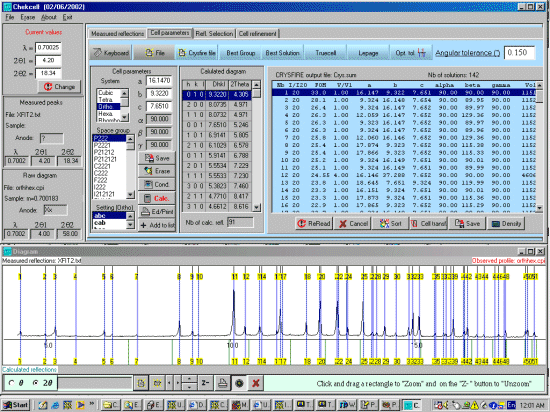
CHEKCELL: Graphical Powder Indexing helper and Spacegroup Assignment Software that links into the Crysfire Powder Indexing Suite by Robin Shirley
|
Ton Spek's LePage (ported to MS-Windows by Jean Laugier) can reliably obtain the reduced cell and perform sub-cell and super-cell searching. The following will show why this can be a very powerful feature in trying to find the best cell solution. A caveate (July 2002), After running LePage or Truecell, Chekcell now automatically rounds off to the idealised cell angles or lengths. E.g., if a hexagonal cell is found by LePage with angles 90 90 119.99, Chekcell will transparently round this up to 90 90 120. CHEKCELL can be obtained off the web at the the LMGP (Laboratoire des Materiaux et du Génie Physique de l'Ecole Supérieure de Physique de Grenoble http://www.inpg.fr/LMGP/) program suite site at:
|
Warning: Be wary that setting too tight an HKL to peak matching tolerance based on one cell may affect how Chekcell interacts with other cells. When in doubt optimise the tolerance for each cell of interest. One thing to consider is to have a flexible tolerance when doing a Best Solution run through - and maybe gradually tightening up the tolerance and redoing the Best Solution.The example data file is from a synchrotron dataset using Indexing results from the Crysfire Powder Indexing Suite by Robin Shirley.
In this demonstration, we will be demonstrating why making use of Ton Spek's LePage can be a very good thing to always use in evaluating your most promising trial cells. |
|
In the orth_hex directory with the Chekcell distribution,
open up the orthhex.cpi data file, xfit2.txt peak file
and crys.sum Crysfire summary file.
|
|
Select the top, high FOM orthorhombic cell and zoom up the diffraction data.
You will see that it is a very good visual match.
|
|
Despite this good fit, it is a very good practise to run LePage and
search for super-cells and sub-cells to see if these may give a better
fit to the data with a better "parsimony of extra reflections" result.
Click on the LePage Icon to bring up the following screen.
|
|
Select the top Orthorhombic solution. Then under Crystal system, select
the higher symmetry cells (Cubic, Tetragonal, Hexagonal, Rhombohedral).
This makes the result much clearer, but you can also do all and get a
multitude of orthorhombic and hexagonal cells to check if you wish.
|
|
Click on the Run Icon to start LePage. This gives the following
result of two Hexagonal Cells.
|
|
Before any of these new cells can be added to the Summary list,
you must do a Best Solution on the results. Click on
the Best Icon and then the Run Icon to do the
parsimony of extra reflections check.
This shows that the a=b=18.644 and c=7.651 hexagonal cell is a superior solution to the Orthorhombic solution as it only needs to calculate 67 HKLs to match the 51 peaks. While the Orthorhombic has to calculate 91 HKLs to match the 51 peaks.
|
|
Select the cell you wish to add to the Summary list and click on the
Add to summary list Icon.
|
|
Now close out of Best solution for LePage and
Lepage to get back to the Chekcell main screen.
The LePage derived solution will now be at the top of the Symmary list. You may want to save this into a new summary list so the result is archived using the Save Icon. This will create a Chekcell (*.ckm) summary file. You will note the new Hexagonal solution fits the data just as well - with less calculated HKLs than the Orthorhombic solution.
|